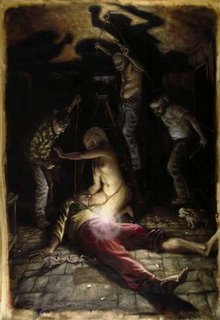Percussion Done Well and the NSO's Nearly Quotidian Mandarin
 Building yourself an orchestra, section by section, is the topic of the current run of concerts of the National Symphony Orchestra under Leonard Slatkin. It starts with a performance of Stravinsky’s Symphonies of Wind Instruments (the 1920 version), which foreshadows the car-honking works of Adams, Reich, Ravel, Varèse, in all its beautiful cacophony. Varèse’s music, especially, shines through; more notably than any of Debussy’s might, in whose memory the Symphonies found their origin. The first five minutes of this less than a dozen minute-long work have a touch of Le Sacre in their rhythm; it ends with an intonation of its own kind of quirky chorale.
Building yourself an orchestra, section by section, is the topic of the current run of concerts of the National Symphony Orchestra under Leonard Slatkin. It starts with a performance of Stravinsky’s Symphonies of Wind Instruments (the 1920 version), which foreshadows the car-honking works of Adams, Reich, Ravel, Varèse, in all its beautiful cacophony. Varèse’s music, especially, shines through; more notably than any of Debussy’s might, in whose memory the Symphonies found their origin. The first five minutes of this less than a dozen minute-long work have a touch of Le Sacre in their rhythm; it ends with an intonation of its own kind of quirky chorale.
F. Mendelssohn, Octet, Quintets et al., Hausmusik |
For freshly composed works of classical music, ‘percussion’ is a favorite instrument. Perhaps because percussion is “cool”? Rock music associations? (Never mind that I’ve always been more reminded of Hard Rock and Metal by a headmoshingly good Bartók string quartet than anything involving mostly percussion…) Whatever the reason for the current flurry of works for percussion and the accompanying pitfalls of anything en vogue (much quantity, little quality), they rarely achieve lift-off.
These lines might serve as a prelude to a modern percussion concerto disaster; alas, they are instead to contrast today’s always met and ‘exceeded’ low expectations with the bristling performance of one of the works that started it all. Carlos Chávez’s Toccata for Percussion. If it is fair to assume that anything following a trend may likely be of low quality, it seems similarly reasonable to suppose that anything that is the source of a trend is good (or must at least have plenty of merit) - and the two earliest percussion-only works support this claim. The first was Edgar Varèse’s Ionisation, the second the above-mentioned Chávez, played by the few members that didn’t get out to play in either the Stravinsky or Mendelssohn.
In three movements, it’s tock-tock in the Allegro, sempre guisto (just percussive elements), pling-plang-boom in the Largo (rhythm instruments with pitch and heavy timpani support). In the Allegro un poco marziale (“un poco marziale” is a joke, right?) it all comes together grandiloquently or grandiosely (one of the two) for a plink-tock-boom-plang-chuck’n’crash percussionist showdown. Cool stuff that has its roots audibly in Antheil and Stravinsky, neither of whom ever wrote for just percussion – but both of whom would at times treat all other instruments as if they were.
Daniel Ginsberg, From Many Instruments, A Wholly Glorious NSO (Washington Post, May 12) |




















































